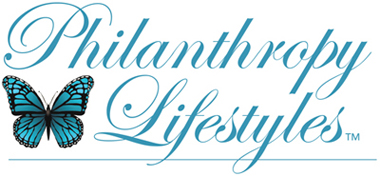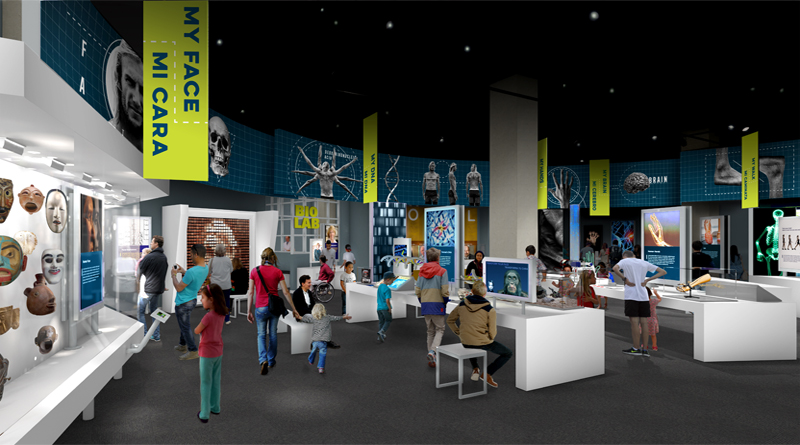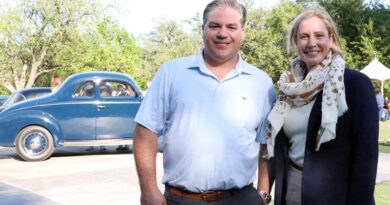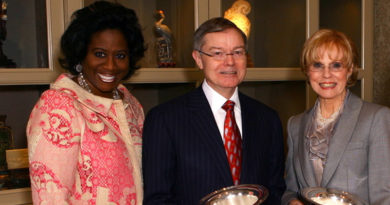Perot Museum of Nature And Science’s Being Human Hall Undergoes Major Transformation as Part of Promise to Keep Content Fresh And Relevant – New Exhibit Hall Debuts To Public May 11
After months of construction, the completely refreshed Being Human Hall will feature twice as many interactive exhibits presented in English and Spanish, allowing visitors to use their brains to fire off pulsing lights, digitally blend their faces with early humans, explore DNA, be inspired by Nobel Laureates, lift their voices and more
Fulfilling a promise to keep content fresh, relevant and exciting, the Perot Museum will unveil its first completely transformed exhibit hall since its 2012 opening more than five years ago. On Friday, May 11, the reimagined Being Human Hall will be unveiled to the public with twice as many interactive displays than the original hall, an array of innovative content, and dozens of experiences, all offered in English and Spanish. In a fascinating and highly entertaining manner, guests will be transported through seven components of the human journey plus enhanced Bio Lab and Nobel Prize experiences, as they explore the traits and abilities that are essential and unique to being human – from early origins and DNA; to the complexities of the brain, hands, face and voice; to the miracle of movement.
Adorned with boldly colorful graphics, images and digital media, the inviting hands-on content will concentrate on the many aspects of what it means to be human. Fresh and invigorated content will center on research and discoveries spanning from the days of early ancestry, to modern-day characteristics, to the scientific breakthroughs of local Nobel Prize Laureates. Not to be missed is a virtual-reality experience that puts visitors in the middle of the South African cave where internationally acclaimed paleoanthropologist Dr. Lee Berger recently identified a new species of human relative,Homo naledi. (NOTE: Berger recently announced his affiliation as the Museum’s new distinguished science advisor of its Center for the Exploration of the Human Journey).
“The transformation of the Being Human Hall delivers on a commitment Museum leaders made early on – to keep visitors curious and engaged with scientific content that is fun, topical and compelling,” said Dr. Linda Silver, Eugene McDermott Chief Executive Officer of the Perot Museum. “We believe guests will be thrilled with the captivating design, the ‘must-be-touched’ bilingual content, and the cutting-edge exploration of a universally popular topic – ourselves!”
The central theme that guides the exhibit is that the “story of you begins with your ancestors; it travels through your DNA; it is held in your hands; it moves as you walk; it is heard through your voice; it is written in your brain.”
Visitors will encounter everything from a preserved human brain and spinal column, to a vein viewer, to a “true mirror” that reveals how others perceive them. Guests will be able to “see” their voices, test their agility and hand-eye coordination through maze balance boards and a large-scale “Operation game-style” buzz wire activity, and try on a prosthetic running blade. They’ll come face-to-face with “Lucy,” the well-known early human relative Australopithecus afarensis; a dogface puffer fish with personality (and DNA that is strikingly similar to humans); and their own faces, hands and strides in a whole new light. Regional accents will be examined, and brain power will be used to fire off pulsing lights. Additional highlights are below.
My Face. In this age of instant selfies, the entrance gallery of the new hall invites guests to visualize and analyze their faces in unexpected ways. The variety of human faces and their connection to personal and cultural identity is explored through a display of masks from around the world, and visitors are encouraged to create their own take-home wire sculpture self-portraits. And the popular Wooden Mirror – that uses a tiny camera to capture a guest’s image and interpret it as pixelated wooden tiles – is back, but with a new hyper focus on the face.
My DNA. This section of the hall explores how DNA helps humankind understand who they are and from where they come. Guests can bring early humans to life and see how small shifts in DNA can alter appearance by transforming their very own faces into Homo erectus orAustralopithecus afarensis. Digital touch screens will allow visitors to manipulate characteristics like eye color and hairline to create imaginary offspring and to trace the movement of humans through history and geography. Not to be missed is a dogface puffer fish with a big personality who playfully interfaces with guests while holding intriguing connections to human DNA.
My Hands. Fun facts about these intricate appendages greet guests to this section along with an examination of how humans use and communicate with their hands. Visitors can challenge themselves – or their friends – in a “text versus type” speed challenge, a test of strength while hanging onto wall grips by their fingertips, or a dexterity demonstration as they attempt to run a wand through a puzzle without setting off the buzzing alarm. Guests also can explore a prosthetic hand while watching video testimonials explaining how the devices have restored capability and improved the lives of fellow North Texans. Finally, guests can view the veins in their hands using near-infrared light and mimic a bionic hand performing sign language.
My Brain. Brains allow humans to make sense of and interact with the world, but sometimes the way brains perceive things might be surprising! Why is it so hard to draw while looking in a mirror? How can one set of words look like something, but sound like something else? A “true mirror” flips guests’ faces twice, allowing them to see themselves not as they normally would in a mirror, but as others see them or as they appear in photos. An interactive “hand changer” befuddles the brain by modifying what visitors see when they look at their own fingers. By merely thinking, guests can send brain wave messages through a headband of circuits to fire up colorful pulsing lights. Visitors must coordinate their eyes, ears and muscles to balance and steer a ball through a maze while standing on a shifting platform. Stories from those impacted by brain injury explore neuroscience and research to retrain the brain. Finally, guests will get an up-close view of one of the world’s only displays of a human brain with a still-intact spinal cord, thanks to a partnership with UT Southwestern Medical Center.
My Walk. In one of the most physically active sections of the hall, guests will strike pose after pose to duplicate the upright figures on an interactive screen or capture their own upright gait in a digital tracker. Guests can see how prosthetics provide balance and coordination to those less able and even try on a prosthetic running blade to learn how they restore the many functions that knees, muscles, ankles and feet provide. Nearby touchscreens elaborate how Dallas scientists develop these amazing tools and how they are using technology to evaluate and enhance the speed and power of athletes.
My Voice. The human voice can communicate complex thoughts and emotions. An interactive voice visualizer lets guests “see” their voices in shape, color and size on a giant screen while a vocal identifier projects words through different accents heard around the U.S. Interactive microphones allow visitors to alter the pitch of their voices with the turn of a dial and confuse their brain’s cognitive processes by speaking words that play back on a slight delay.
Becoming Human. Visitors are encouraged here to explore where they fit into the evolutionary tree. Casts of fossil skulls, hands and feet invite guests to compare themselves to early humans. A dozen authentic stone tool artifacts, some more than a million years old, are displayed by a full figure of “Lucy,” the famous Australopithecus afarensis.Groundbreaking research from world-renowned paleoanthropologist Dr. Lee Berger, the newly named distinguished science advisor of the Perot Museum’s Center for the Exploration of the Human Journey, explains how he and his team of scientists learn about human history through the fossils predecessors left behind. A virtual reality experience, developed by Grooves Jones, transports guests into the South African cave system where Berger discovered a new species of human relative.
Bio Lab. This guest-favorite lab experience is returning with new, hands-on experiments for guests 8 and up. Use bone models and rocks to solve an anthropological mystery, explore how separating liquids is similar to separating DNA, examine electricity within a living worm, and extract wheat DNA for inspection under a microscope.
Nobel Laureates. Large-scale video portraits of Nobel Prize winners from the region hang above the medals bestowed to them, inviting visitors to get to know these scientists and learn why Dallas is considered a leader in biomedical research. New to the exhibit is the Breakthrough Prize in Life Sciences – considered the “Academy Award of Science” – awarded in 2016 to Dr. Helen Hobbs, a geneticist with the UT Southwestern Medical Center.
The Being Human Hall is on Level 2 of the Perot Museum, which is located at 2201 N. Field Street in Dallas, Texas. For more details, visit perotmuseum.org or call 214-428-5555.
Highland Capital Management is the 2017-2018 Premier Partner of the Perot Museum.
About the Perot Museum of Nature and Science. The top cultural attraction in Dallas/Fort Worth and a Michelin Green Guide three-star destination, the Perot Museum of Nature and Science is a nonprofit educational organization located in Victory Park in the heart of Dallas, Texas. With a mission to inspire minds through nature and science, the Perot Museum delivers exciting, engaging and innovative visitor and outreach experiences through its education, exhibition, and research and collections programming for children, students, teachers, families and life-long learners. The 180,000-square-foot facility in Victory Park opened in December 2012 and is now recognized as the symbolic gateway to the Dallas Arts District. Future scientists, mathematicians and engineers will find inspiration and enlightenment through 11 permanent exhibit halls on five floors of public space; a children’s museum; a state-of-the art traveling exhibition hall; and The Hoglund Foundation Theater, a National Geographic Experience. Designed by 2005 Pritzker Architecture Prize Laureate Thom Mayne and his firm Morphosis Architects, the Victory Park museum has been lauded for its artistry and sustainability. To learn more, please visit perotmuseum.org.
About Groove Jones. Groove Jones is a Dallas-based technology studio specializing in 360 VR media commercial productions, augmented reality applications and interactive digital experiences. Founded by industry leaders, the team has a proven track record of collaborating and doing what’s never been done before – anything to achieve our client’s goals. For more information, please visit groovejones.com.
(Write-up courtesy Perot Museum of Nature and Science.)




